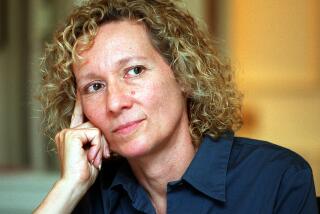Isabel Bishop; Painter for Six Decades
- Share via
Isabel Bishop, widely regarded as one of the finest figure painters of modern times and who once described her celebration of the common woman as an effort “to catch the fleeting moment without freezing its flight,” has died in New York City where she spent six decades sketching.
She was 85 when she died at her home in the Bronx on Friday.
From the working girls of the Great Depression to the young students strolling in her beloved Union Square, she was praised for extending into modern times the tradition of northern European 17th-Century figure painting.
She cherished that connection and once said that “you may have true gifts and the ability to make something that is new and surprising, but if your work hasn’t any connections and your gift gives out, you haven’t any leverage.”
Although centered in New York throughout her life, her graphic depictions of the comings and goings of working women, “bag” ladies, shoppers and derelicts evolved into a national identity. Miss Bishop’s work was first seen on the West Coast in 1985 at a widely heralded exhibit at Loyola Marymount University where William Wilson, The Times art critic, found her oeuvre “a woozy disjunction in time and place. . . . When everything was always gonna be OK because you had a coupla bucks and an American dream. . . . “
Everyday Characters
She came to New York in the early 1920s and studied at the Art Students League with Kenneth Hayes Miller. His devotion to the everyday characters inhabiting the urban sprawl heavily influenced her.
Miller perpetuated modern art, but only as the old masters might have interpreted it. With Miller and Reginald Marsh, one of Miller’s best-known students, Miss Bishop toured Europe in 1931 to study the great drawings and paintings there. It was the first of many such trips where she learned the Rembrandt-like naturalness that dominated her works.
She came to be an apostle of the so-called Ashcan School, a group of New York realists whose backgrounds embodied garbage cans, alleyways and back yards. One of her drawings, a 1935 ink wash of a derelict, she titled “The Ash Can.”
By the mid-1930s she had become affiliated with the Midtown Gallery, where her one-woman shows had since been seen. She married in 1934 to neurologist Harold G. Wolff, and that and a small inheritance eased her financial plight. She then became free to view the world from her window at Broadway and Union Square, wearing the sneakers and white smock that became her signature.
Her many honors included last year’s Gold Medal for Painting from the Academy and Institute of Arts and Letters.
More to Read
The biggest entertainment stories
Get our big stories about Hollywood, film, television, music, arts, culture and more right in your inbox as soon as they publish.
You may occasionally receive promotional content from the Los Angeles Times.










